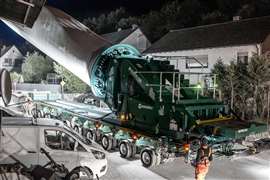Supply down, demand up
20 March 2008

Need some extra cash? Easy. Dust off the 15-year old crawler crane in your fleet, tune it up, give it a fresh coat of paint, put it up for sale and watch the dollars roll in. For the second year running, the market for used cranes is vibrant, and the good news is that it appears demand will continue to be strong. The bad news is that the supply of used cranes has trickled down to a bare minimum, and prices are sky high.
The continued backlog for new cranes from manufacturers can mean well over a year wait time. Those looking to purchase a unit pronto are forced to attend auctions, call brokers and scour other sources for a unit. The internet continues to be a resource for used crane sellers, with the occasional unit available on eBay. A strong dose of good luck is about as much as one could hope for on stumbling in the path of a machine for sale. And, if one does find a unit for sale, the price tag may seem incredible. Reports continue to come in of five-year-old machines selling at auction for more than their original retail prices.
“The used market is following that of the new crane market: that is a high demand, lack of availability, thus high values,” says Pete Gipson, South-Central US sales manager for Iron Planet equipment auctioneer. He explains that from 2000 to 2004, a softer US economy caused manufacturers to pull back in production.
“Now the US economy is strong, and other parts of the world such as India and the Middle East are growing their infrastructures and availability is poor,” says Gipson. “All contribute to the high demand and product shortage on both the used and new side.”
A quick search on IronPlanet's web site shows very few listings of cranes available at upcoming auctions, bar a handful of rough terrain models.
“Generally speaking, all crane types from rough terrain to tower cranes are enjoying good activity,” says Gipson. “More tower cranes are working in Dubai than any place in the world. The growth in infrastructure in some parts of the world is sucking up all the large cranes, from crawlers to mobiles. Here in the US, drilling and oil related industries are demanding cranes. The Gulf Coast region is demanding pick-and-carry products to handle steel and pipe, thus down cab RT cranes are twice as valuable as they were say three years ago. Used product will remain a valuable commodity.”
Denis Prevost, vice president of national accounts for Ritchie Bros. Auctioneers, says the Canada-based auction company is seeing fewer cranes at its auctions. Those machines available, however, are going for higher and higher prices than what has been seen in the past. At a Ritchie auction in Lincoln, NE held in June 2007, a 60 ton Grove 760E model year 2000 went for $290,000. At the same auction, a 1989 75 ton Link-Belt LS138 H crawler sold for $245,000.
“If you have a used crane right now to sell, you're probably going to make a lot of money,” Prevost says, adding that regardless of the age, if the machine is functioning well, it will be sold. And if it is in need of repair, Ritchie does have capabilities of refurbishment.
“Presentation, presentation, presentation,” says Prevost. “We can do mechanical work, put on new rope, new paint, sometimes just reupholstering a seat will bring the overall condition up to where you're going to get the most money for it.”
At press time, Prevost says Ritchie collectively has just 150 used cranes for sale worldwide.
Slim pickings
On a much smaller scale, US Auctions’ Wilmington, DE branch does not see many cranes roll through it auctions. However, in June, Marty Piela, vice president of East Coast for US Auctions, reports that a 15 ton rough terrain Dresser 150 ARS had just come to its doorstep. In his region, Piela says most equipment on the auction bill is from utility companies. He says 10 years ago, many utility companies owned their own fleets. Today, these companies tend to rent the cranes they need or employ a subcontractor.
Piela says rough terrain cranes are the highest in demand. A 40-year industry veteran, Piela remembers back 20 to 30 years ago used machines selling for as much as a new crane, depending on its condition. US Auctions does not refurbish equipment.
Rental companies and dealers are reporting the same trends. Patrick Henry, vice president and general manager at Detroit's Laramie Crane & Truck, says large hydraulic rough terrain cranes and crawler cranes are not just the highest in demand in Michigan, but everywhere.
“I think this time last year was the beginning of the demand for cranes,” says Henry. “Now the demand is so great … you have to go to used cranes and they are drawing a premium right now.”
Laramie, a fourth generation company in business since 1917, says recently his company sold off a lot of its older cranes, made new purchases and refurbished older models to keep in their feet. The company recently received several new Manitowoc cranes: three 300 ton capacity Model 2250 crawlers, two Manitowoc 14000 crawlers; and eight new Grove rough terrains.
Bruce Stemp, project manager for Lampson International, says it is the simple law of supply and demand as to why the prices of used machines are going for premiums. “When fleet operators are unable to purchase new and look to the used market to add to their fleets, that increased interest in the used equipment drives prices up,” he says. From his perspective, he says that almost all sizes and types of cranes are in high demand.
“If I had to pick a specific sector I would say those with capacities over 150 to 200 tons,” Stemp says. He says contractors are willing to pay higher rates just to ensure equipment availability.
Dealers realize that if a customer asks for a new crane, they will be told to sit tight for a year, maybe two. Uli Mack, sales manager for Marco Cranes, a Link-Belt dealer headquartered in Phoenix, AZ, reports that because of the availability of new cranes could be as far out as next year or even 2009, the prices for used cranes will continue to rise. Prices on used machines have risen twice this year, which coincides with increases on new machines.
“We've seen cranes sell for more money than they were purchased for,” says Mack. “You can have a crane that's four years old and turn around and sell it for more money than purchased for.”
Mack admits that Marco carries many older model cranes that are sitting idle and thinks it would be good to get those up and running. “We're behind the eight ball on that,” he says.
Beyond dealers, many of those looking for cranes turn to brokers. These “iron peddlers,” as one referred to himself, are also a resource for finding cranes. But what magic can they work that the dealers can't? Right now, the shortage doesn't tend to discriminate.
David Stephens, a broker for Mitchell Companies in Meridian, MS, concurs that sales are strong, and availability is limited. He says 50 to 60 ton capacity rough terrains and 100 to 300 ton capacity all terrains are the highest in demand. Because of the lack of machines available in the US, Mitchell is buying cranes overseas. However, he thinks contractors are more willing to wait for newer machines than to buy older makes.
“Everyone wants to upgrade and are willing to wait up to two years on a new crane,” Stephens says. “Most just try to get by with their used cranes until their new ones arrive.” operational. According to Jay Shiffler, vice president, the restoration process involves total refurbishment, taking it down to the bare chassis and rebuilding it to like-new condition. A SLEP investment involves working with the customer to develop a scope of work that will bring the crane up to their performance expectations and stay within their budgetary constraints.
“To me, the market for SLEP and total restoration is not real active right now but as the market softens, we expect it will get better and improve,” Shiffler says. “People simply don't want to take any crane out of service unless it's absolutely necessary.”
Ralf Vieten, executive vice president of service for Liebherr's US operations, reports the same level of activity, citing that most owners have all of their machines rented out and don't want to take the time to service the equipment, unless absolutely necessary. He says that the parts and components business is solid. “We have a good stock and are upgrading our stock per customer demand,” says Vieten. “Within 48 hours most customers are taken care of.”
The company services and refurbishes cranes at two facilities, in Houston, and Newport News, VA. Like WHECO, Liebherr can completely take apart a unit and rebuild it. However, Vieten says most of the machines that need such intensive repair are those that have been involved in an accident, such as a tip over. In other words, remanufacturing requirements currently only demand what is necessary. “If there is a repair, it's minimal to get it back on the road,” says Vieten.
Gipson at Iron Planet says parts and components are becoming more difficult to procure. “The reason is, companies are forced to rebuild what they have because new ones are too expensive to replace or are not available, period,” he says. “Have you ever wondered why companies seldom part with their old, tired cranes? For just such circumstances as we are in today. They can refurbish those units and get them back in use or they can rob components and parts and keep other units going. Crane users are a resourceful group. Quality used cranes are money in the bank.”
STAY CONNECTED


Receive the information you need when you need it through our world-leading magazines, newsletters and daily briefings.
CONNECT WITH THE TEAM










